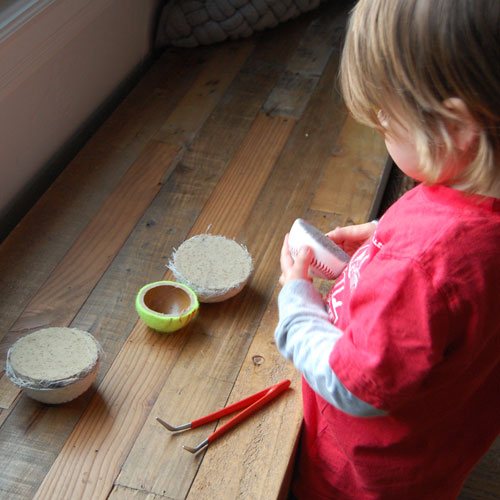Children will apply scientific inquiry to a familiar topic – sports! Working with the physics and materials of sports, children will investigate the cross sections of balls. They’ll then make their own to test for bounce.
Materials Required
- Fabric
- Rubber bands
- Bouncy balls
- Stuffing
- Uninflated balloons
- Rubber bands and/or binder clips
- Items to add weight, such as paper clips, coins, or dry rice
- Needle and thread
- Tape
- Corks
- Yard sticks
- White boards/dry erase markers
- A variety of athletic balls, such as:
- Golf
- Baseball
- Softball
- Bouncy ball
- Tennis
- Dissection tools:
- Magnifiers
- Microscopes
- Slides of ball materials
- Tweezers
- Dissection kit (e.g. scalpel, spatula, forceps, scissors, pointers)
Instructions
- Challenge children to design, build, and test their own ball using fabric, rubber bands, bouncy balls, stuffing, and other materials. Older children can use needle and thread to finish constructing their balls.
- Once they have created their balls, ask children to test them. Bounce the balls off of a step against a yard stick, and record on a whiteboard the height of the bounce for each one.
- Compare and contrast how high each ball bounces to the other balls designed, and to the sports balls (soccer ball, tennis ball, etc.) you’ve collected. What do you notice about the way the ball is made? How does it relate to the height of the bounce?
- Try these design challenges or make your own:
- Make a ball that will bounce at least 3 feet high.
- Make a ball that will bounce 5 times in a row.
- Make a ball that is heavier than a baseball and can be bounced at least 2 feet.
Additional Tips
Try these add-on activities:
- Support children to investigate the links between the design/construction of balls and the sport itself. Use the internet, play the sport, or watch the sport together live or on TV. Ask, “What do you think the inside of a baseball/softball/golf ball/tennis ball is like? Why do you think it is that way? What can you tell me about this sport? Does that help explain why its ball is built that way?”
- After testing the balls they have created, ask children, “What materials would you use to build a faster/bouncier/more aerodynamic ball?”
- Find old balls that you are willing to cut apart so children can see the insides. Using microscopes, magnifiers, tweezers, and other simple hand tools, children can look at, pull apart, and compare different cross sections of golf balls, baseballs, softballs, tennis balls, and other assorted balls. Encourage close observations of the materials, construction, and shapes of the sports balls (How raised are the seams? How dense are the dimples on a golf ball? How thick is a tennis ball?). Push them to speculate about why it might be made that way. Ask: “Why do you think a golf ball has divots?” “How do the seams on a baseball change the way it moves?”


